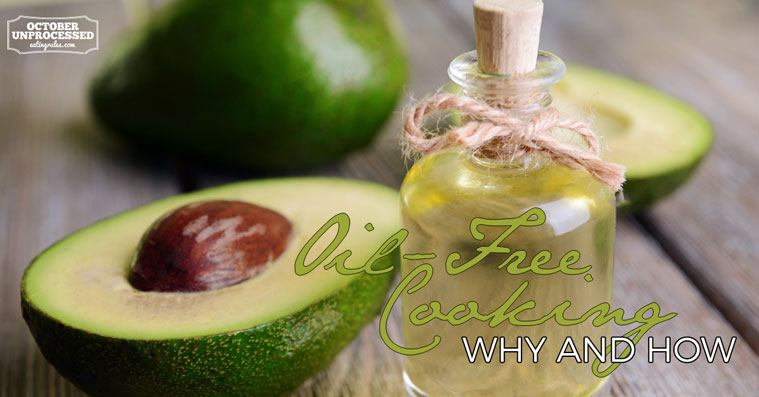Why (and How!) to Cook Oil-Free
Oct 12, 2017

Despite rational and clear guidelines, even the world of unprocessed eating has its minor controversies and debates. Case in point: Oil.
Oil, like fruit juice, is not a whole food but rather an extracted part of a whole food. In the same way that apple juice does not contain the same nutrition of a whole apple, the same can be said about avocado oil and avocados.
Half of one avocado clocks in at 161 calories and also provides:
- 10 grams of heart-healthy monounsaturated fat
- 7 grams of fiber
- 16 percent of your daily vitamin C needs
- 26 percent of your daily vitamin K needs (a very important nutrient for bone health!)
- 20 percent of you daily folate needs
- 15 percent of your daily potassium needs
Meanwhile, four teaspoons of avocado oil provide 160 calories, along with:
- 12.5 grams of heart-healthy monounsaturated fat
… aaaaaand that’s it. Nothing to scoff at, but certainly not in the same nutritional league as what you get in a whole avocado’s package.

This is why my nutrition advice for years has been to prioritize whole food fats over oils. The hype and marketing craze over “healthy oils” has clouded our perspective and can make us believe that an extract of a whole food is one of the healthiest foods in the world.
Yes, certain oils’ fatty acid compositions impact our triglyceride and HDL levels differently than others (see the cooking oil comparison chart Andrew and I created several years ago), but whole-food fats deliver the best nutritional bang for your buck – especially when you consider the presence of potassium, magnesium, and fiber, which the average American diet lacks.
“Okay,” some of you may say. “I get that eating fats from whole foods is better than oil. But… there’s only so much sliced avocado I can add to my salads… and snacking on almonds can get a little boring.”
I hear you – which is why I also want to provide some creative ideas on how you can replace cooking oils with whole food fats:
- Use raw cashews as the base in soup recipes. My five minute blended mushroom soup is hearty, creamy…and oil-free! If mushrooms aren’t your thing, replace them with kale or corn for a different flavor profile.
- Use nut and seed-based dressings and sauces. Oil-based vinaigrettes are a cinch to make, but the same can be said for salad dressings made with whole-food fats. My garlic-tahini dressing goes great over steamed autumn vegetables, pilafs, and salads. The fat comes from tahini (sesame seed butter), which is also a good source of thiamin, phosphorus, manganese, and iron.One of my favorite plant-based cookbook authors, Dreena Burton, has a fantastic recipe for an oil-free curried almond dressing that always delivers (and is another way to add nutritious almonds to your day when you need a break from snacking on them or adding them to oatmeal).One alternative to the tried-and-true “coat vegetables in olive oil and then roast” technique: dry roast them in a sheet pan (to prevent sticking, use parchment paper) and then dip them in or drizzle them with a creamy oil-free sauce, like this spicy peanut-cilantro one or this oil-free pesto.
- Satisfy your sweet tooth without oil. Many unprocessed desserts and baked goods focus on healthier flours (i.e.: coconut, almond, oat) but often get the majority of their fat from oil, rather than whole foods. There are exceptions, though: chocolate avocado pudding, cocoa-tahini brown rice squares, and gooey black bean brownies (opt for dark chocolate chips for a higher amount of stearic acid, a healthful fat in cocoa).
The idea isn’t to omit oil (yes, you can sauté using water or vegetable broth, but nothing can replicate the flavor of garlic sautéed in a good-quality olive oil) but rather to make healthful whole foods your go-to ingredients when fat is required in a recipe.
Bon appétit!





















This way of eating is extremely difficult or impossible for so many. The stats now show that 1 out of 100 people have a peanut and/or nut allergy, including myself. While I would love to use nut flours for their benefits, safely, I cannot. So many healthy recipes call for nuts, none of which I can use (unless I can buy and splurge on blue diamond products as they are peanut-free). BTW, most nuts are contaminated with other nuts as they are processed together. Did you know that many people allergic to peanuts or nuts cannot tolerate avocados either? Why, I don’t know but there is a link, coincidence or not. I am one of them. Some people say it’s a latex-food allergy as well (latex-foods are avocado, banana, kiwi, water chestnut, and a few others). So, while these ideas are fabulous, I hope food bloggers will read this and… Read more »
Hi Melanie – I didn’t know there’s a connection with nut allergies and avocados, bananas, etc., so thanks for bringing this up. I just looked through the dessert recipes on my site, and found a few options that may work for you. Enjoy!
Pumpkin Chia Seed Pudding (adjust the almond milk and garnish as needed)
White Chocolate Pumpkin Dip
Roasted Fruit with Pomegranate Molasses (uses a tiny bit of oil to keep the fruit from sticking)
Vegan Chocolate Espresso Zucchini Brownies
Bourbon Pumpkin Rice Pudding
No-Bake Energy Bites (easily adapted to seeds/nuts that work for you)
Thank you! I am diabetic an in remission from cancer and have switched over from the high meat(albeit lean and healthy meats) with greens and only a few berries to a plant-based Diet. Dr. Fuhrman & Dr. Barnard both say no to oils and that is what contributes to my insulin resistance. For years I have been working out hard core and putting low or no carbs in my mouth only to have my blood glucose read 300 or more AFTER a 10k or a triathlon!! Now I am having faith that the above mentioned doctors are right and I thank you for your confirmation and acknowledgement that even organic stores don’t often have sugar-free(without maple syrup or agave) products or oil-free dressings. I will definitely try out your recipes!